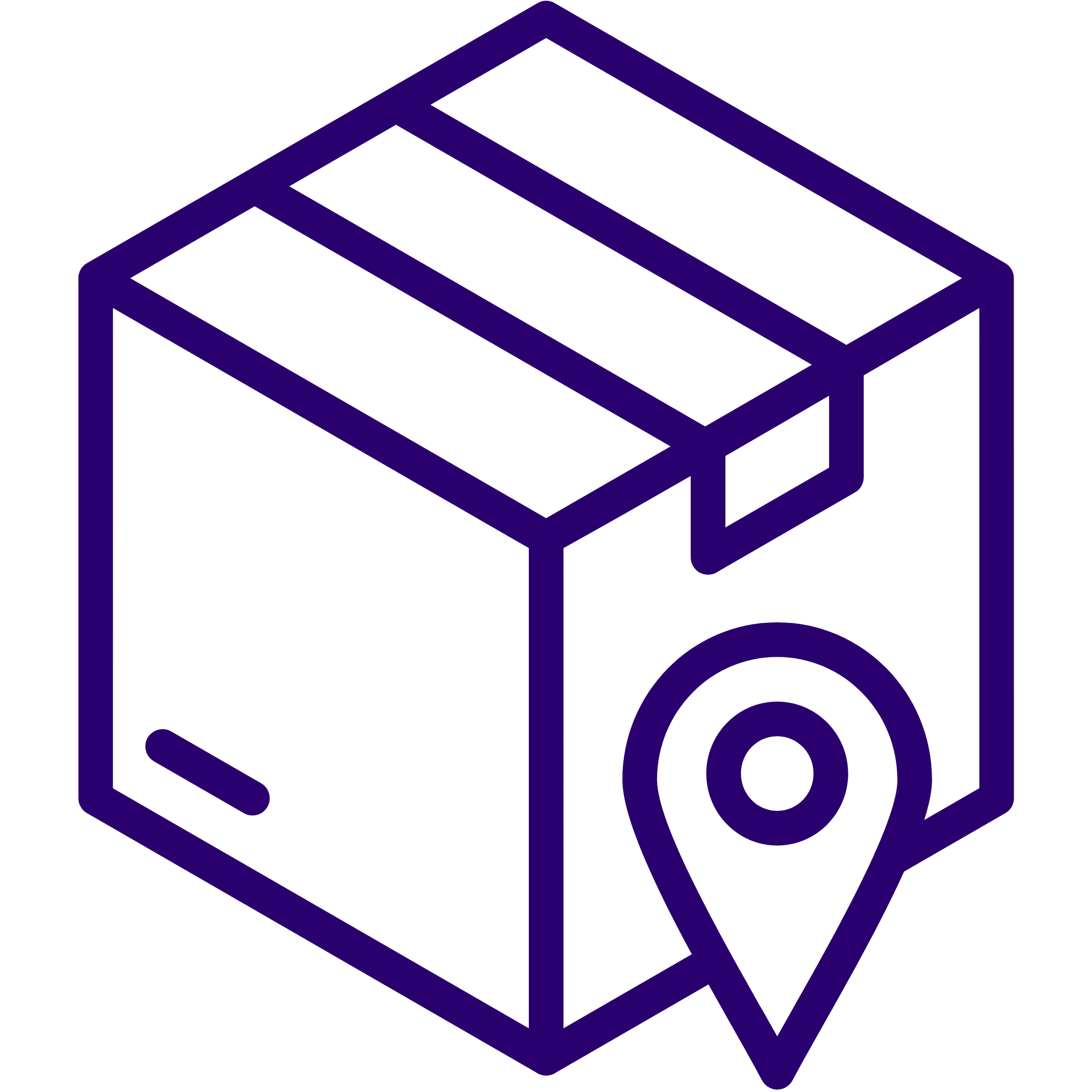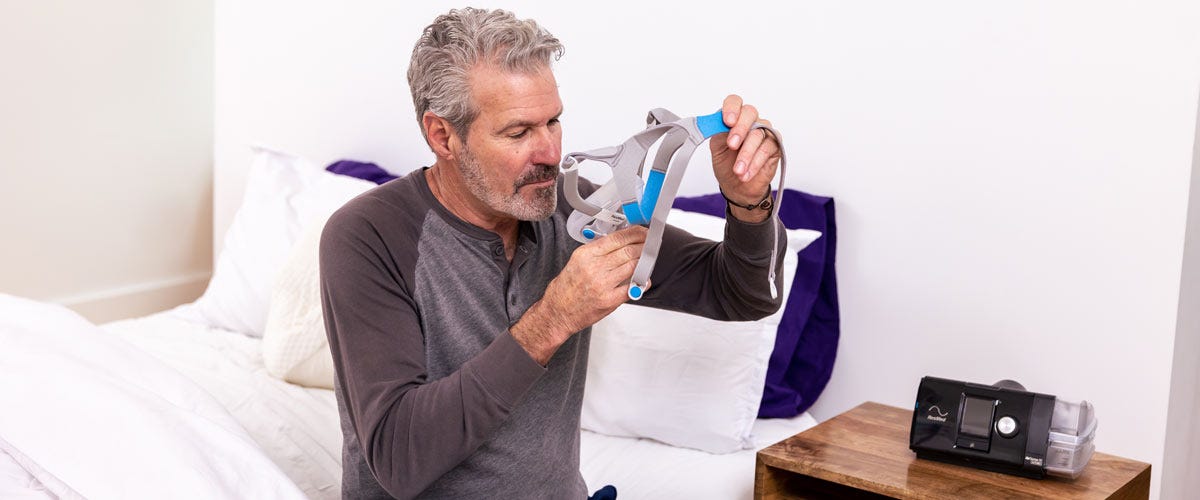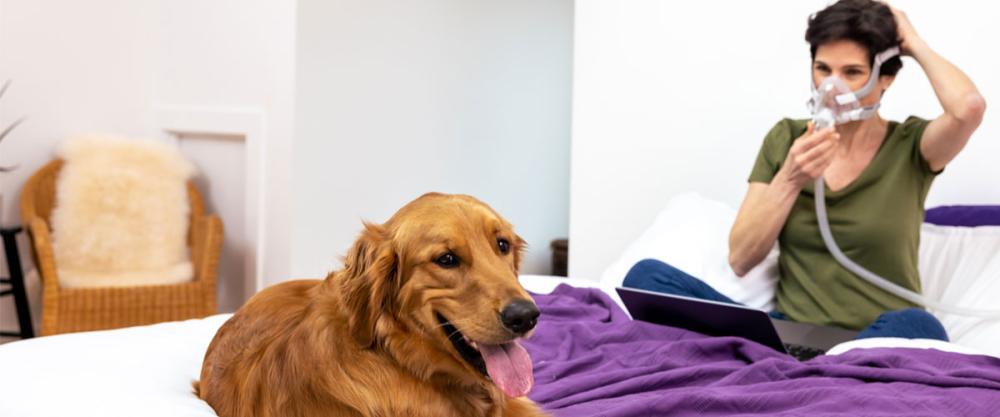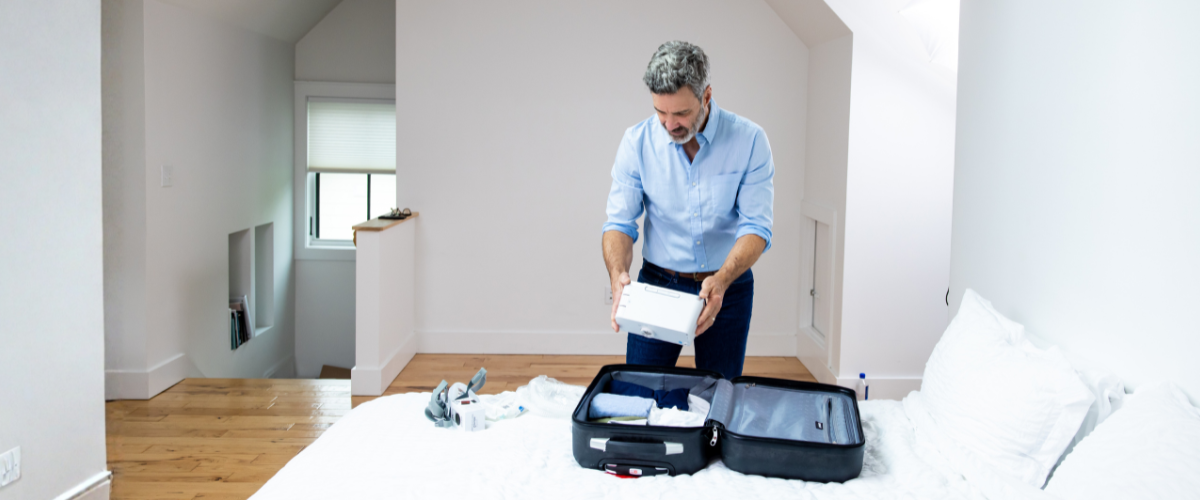After being diagnosed with sleep apnea you're given a lot of information about CPAP therapy is a short amount of time. It can be easy to miss crucial information about what every little part of your CPAP is for, especially when it comes to CPAP mask parts.
However, when getting to know your CPAP machine it’s important to determine how you feel most comfortable by trying out a few different types of CPAP masks. Even though a mask may seem as simple as pulling on and going to sleep, different options have different parts that make a major difference. The more you know about them, the more comfortable your treatment will become as you’ll be able to choose the best mask to suit your individual needs.
 Full face CPAP masks are often the best CPAP masks for mouth breathers because the frame covers your nose and mouth, creating an airway seal for both airways. The mask is held in place with side straps.
Full face CPAP masks are often the best CPAP masks for mouth breathers because the frame covers your nose and mouth, creating an airway seal for both airways. The mask is held in place with side straps.
Generally, full face masks are used by patients who need a higher pressure setting because it disperses the pressure instead of sending it directly into the nose. People with allergies and frequent congestion also need full face masks to receive oxygen when their nostrils are blocked due to mucus.
Because this mask takes up more surface area on the face, it’s better for people who sleep on their backs. It may come displayed more easily than other masks if you sleep on your side. Also, the large surface area can make people feel claustrophobic.
Some options connect to the frame from the sides, and some also have a strap across the forehead. They're recommended for those who need higher pressure settings and cater to a variety of facial sizes and shapes and make it easier to read and watch TV while wearing them.
However, this mask can be difficult to use if you have trouble breathing through your nose. Also, sometimes people feel as if nasal CPAP masks place too much pressure on the bridge of their nose and forehead.
 Nasal pillow CPAP masks have lightweight, minimal designs to reduce the amount of contact placed on your face. They are recommended for those who feel claustrophobic and can’t get comfortable in other types of masks.
Nasal pillow CPAP masks have lightweight, minimal designs to reduce the amount of contact placed on your face. They are recommended for those who feel claustrophobic and can’t get comfortable in other types of masks.
They work by having two nasal pillows that rest at your nostril entrances to create a seal that directs the airflow straight into your nostrils. For this reason, they’re generally recommended for those who have a medium to lower prescribed pressure setting.
CPAP nasal pillows are not recommended for mouth breathers and may cause nasal dryness and irritation. However, they do make it significantly easier to wear glasses and watch TV while wearing your CPAP mask.
Also, once you select a mask you can consider what type of parts to get, just make sure they’re compatible.
A backup CPAP mask of a different type is also good to have on hand. For example, if you get a cold that causes congestion, switching from a nasal mask to a full face mask will help you sleep better. Plus, you’ll have one on hand to use if your mask breaks, so you don’t have to give up treatment while waiting for a replacement to arrive.
Clips - CPAP clips are often used to attach headgear to the mask frames. CPAP headgear clips allow you to use a variety of different types of headgear with your mask.
Frame - The CPAP mask frame is the system that holds your CPAP mask together. It holds the cushion, connects the tubing, and connects to the headgear. Frames vary in size based on mask type and to fit different facial features.
Cushion - The CPAP mask cushion is a soft insert, usually made of silicone or gel that goes inside the mask frame. The cushion touches your skin to create a seal that prevents air from leaking. They are available in various sizes depending on what type of mask you have.
Nasal Pillows - CPAP Nasal pillows are soft, cone-shaped inserts that sit at the base of your nose to direct airflow into your nostrils. They tend to be made out gel or silicone and there are a variety of shapes and sizes to fit your nose.
Chin Strap - CPAP chin straps are soft, stretchy bands made out of soft materials to help you keep your mouth closed at night. Some are seamless and others connect with velcro tabs. They help mouth breathers effectively use nasal CPAP masks.
Swivel - The CPAP swivel is a small plastic cylinder that connected the CPAP tubing to the mask. The swivel can often get stuck in the tubing, leading to confusion when people change masks. If your new mask won’t connect to your old tubing, check to see if the swivel is in the end of the hose.
Tubing Elbow - CPAP tubing elbows are adaptors that have a bend to allow you to connect your CPAP hose to your machine at a 90-degree angle. This reduces stress on the tubing connection and allows for a more flexibility from the tubing connection to the bed.
Mask Diffuser - A CPAP mask diffuser is a small filter that is placed inside your mask or swivel to help reduce the amount of noise your mask makes.
However, you don’t have to deal with remembering to regularly replace these items. If you subscribe we will automatically ship your CPAP supplies to your home on a regular basis. Shipping is always free.
However, when getting to know your CPAP machine it’s important to determine how you feel most comfortable by trying out a few different types of CPAP masks. Even though a mask may seem as simple as pulling on and going to sleep, different options have different parts that make a major difference. The more you know about them, the more comfortable your treatment will become as you’ll be able to choose the best mask to suit your individual needs.
CPAP Mask Parts
CPAP manufacturers are constantly making strides towards increasing the comfort and efficiency of CPAP masks based on user experience. This is because they know that patients are more likely to adhere to their CPAP treatment if masks feel better. This has led to the creation of about five different types of masks. While there are hybrid masks and oral masks, doctors generally recommend three main types. Full face masks, nasal masks, and nasal pillow masks.Full Face Mask
 Full face CPAP masks are often the best CPAP masks for mouth breathers because the frame covers your nose and mouth, creating an airway seal for both airways. The mask is held in place with side straps.
Full face CPAP masks are often the best CPAP masks for mouth breathers because the frame covers your nose and mouth, creating an airway seal for both airways. The mask is held in place with side straps. Generally, full face masks are used by patients who need a higher pressure setting because it disperses the pressure instead of sending it directly into the nose. People with allergies and frequent congestion also need full face masks to receive oxygen when their nostrils are blocked due to mucus.
Because this mask takes up more surface area on the face, it’s better for people who sleep on their backs. It may come displayed more easily than other masks if you sleep on your side. Also, the large surface area can make people feel claustrophobic.
Nasal Masks
Nasal CPAP masks only cover the bridge of your nose to your upper lip to deliver airflow directly into your nose. They’re the smaller, more lightweight CPAP masks for side sleepers and are often recommended to those who move around in their sleep a lot.Some options connect to the frame from the sides, and some also have a strap across the forehead. They're recommended for those who need higher pressure settings and cater to a variety of facial sizes and shapes and make it easier to read and watch TV while wearing them.
However, this mask can be difficult to use if you have trouble breathing through your nose. Also, sometimes people feel as if nasal CPAP masks place too much pressure on the bridge of their nose and forehead.
Nasal Pillow Masks
 Nasal pillow CPAP masks have lightweight, minimal designs to reduce the amount of contact placed on your face. They are recommended for those who feel claustrophobic and can’t get comfortable in other types of masks.
Nasal pillow CPAP masks have lightweight, minimal designs to reduce the amount of contact placed on your face. They are recommended for those who feel claustrophobic and can’t get comfortable in other types of masks. They work by having two nasal pillows that rest at your nostril entrances to create a seal that directs the airflow straight into your nostrils. For this reason, they’re generally recommended for those who have a medium to lower prescribed pressure setting.
CPAP nasal pillows are not recommended for mouth breathers and may cause nasal dryness and irritation. However, they do make it significantly easier to wear glasses and watch TV while wearing your CPAP mask.
CPAP Mask Tips
Once you have picked the right type of CPAP mask make sure you pay attention to the sizing charts. Ordering the correct size is necessary to create a leak-free seal around your airways.Also, once you select a mask you can consider what type of parts to get, just make sure they’re compatible.
A backup CPAP mask of a different type is also good to have on hand. For example, if you get a cold that causes congestion, switching from a nasal mask to a full face mask will help you sleep better. Plus, you’ll have one on hand to use if your mask breaks, so you don’t have to give up treatment while waiting for a replacement to arrive.
CPAP Mask Parts Glossary
Headgear - CPAP headgear is used to hold your CPAP mask in place with straps that go around your head. They are generally made of soft, flexible material such as synthetic neoprene and a few options are made of silicone Some have velcro fasteners and others have clips to attach to the frame.Clips - CPAP clips are often used to attach headgear to the mask frames. CPAP headgear clips allow you to use a variety of different types of headgear with your mask.
Frame - The CPAP mask frame is the system that holds your CPAP mask together. It holds the cushion, connects the tubing, and connects to the headgear. Frames vary in size based on mask type and to fit different facial features.
Cushion - The CPAP mask cushion is a soft insert, usually made of silicone or gel that goes inside the mask frame. The cushion touches your skin to create a seal that prevents air from leaking. They are available in various sizes depending on what type of mask you have.
Nasal Pillows - CPAP Nasal pillows are soft, cone-shaped inserts that sit at the base of your nose to direct airflow into your nostrils. They tend to be made out gel or silicone and there are a variety of shapes and sizes to fit your nose.
Chin Strap - CPAP chin straps are soft, stretchy bands made out of soft materials to help you keep your mouth closed at night. Some are seamless and others connect with velcro tabs. They help mouth breathers effectively use nasal CPAP masks.
Swivel - The CPAP swivel is a small plastic cylinder that connected the CPAP tubing to the mask. The swivel can often get stuck in the tubing, leading to confusion when people change masks. If your new mask won’t connect to your old tubing, check to see if the swivel is in the end of the hose.
Tubing Elbow - CPAP tubing elbows are adaptors that have a bend to allow you to connect your CPAP hose to your machine at a 90-degree angle. This reduces stress on the tubing connection and allows for a more flexibility from the tubing connection to the bed.
Mask Diffuser - A CPAP mask diffuser is a small filter that is placed inside your mask or swivel to help reduce the amount of noise your mask makes.
Subscribe To Save On CPAP Mask Resupply Parts!
Over time CPAP mask parts break down and become less effective. The oil from your skin can cause the cushion and frame to deteriorate, leading to leaks. As items break down bacteria and other harmful pathogens can collect and may cause you to get sick. Plus, the headgear can become stretched out, making it difficult to maintain a secure fit.However, you don’t have to deal with remembering to regularly replace these items. If you subscribe we will automatically ship your CPAP supplies to your home on a regular basis. Shipping is always free.













